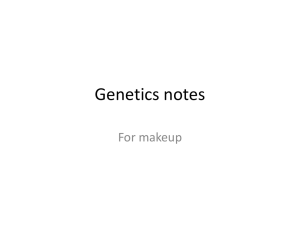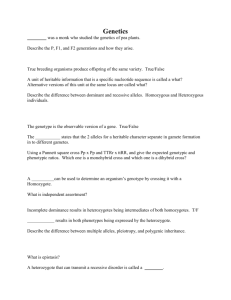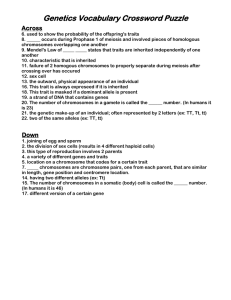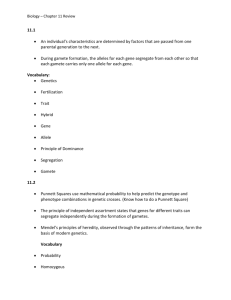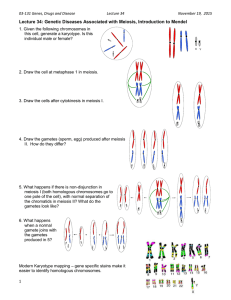Genetics
advertisement
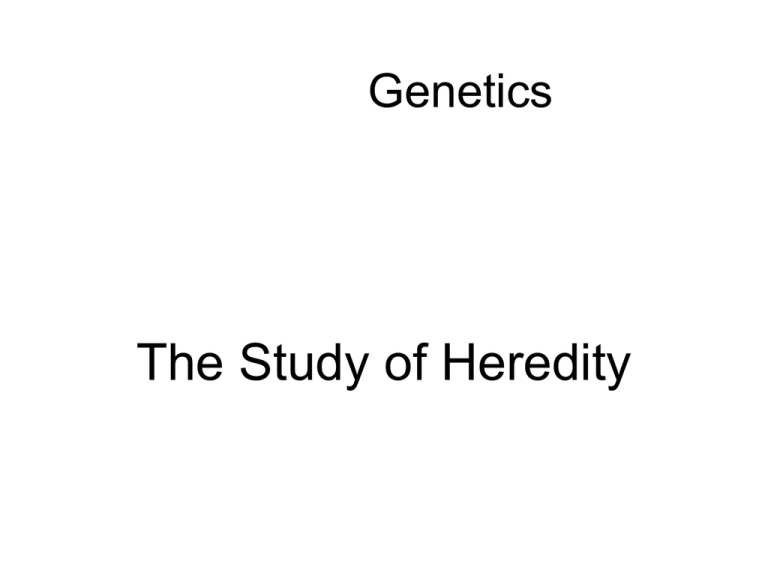
Genetics The Study of Heredity Gregor Mendel • Discovered many of • • the principles of modern genetics Mendel studied the inheritance of traits using pea plants Principles of basic inheritance are called Mendelian genetics Genes • Genes are segments of • • chromosomes that determine the traits of an organism (ex. Eye color) There may be several hundred to several thousand genes on a chromosome We inherit 50% of our genes from our mothers and 50% from our fathers 50% of your genes from dad 50% of your genes from mom Alleles • Every gene comes in different variations called alleles • Most genes have two different alleles while some have more than two • One person can have no more than two different alleles for the same gene (we get one from each parent) Three people with different alleles for a gene involved in eye color Dominant vs. Recessive Alleles • Alleles interact to • produce traits (eye color, shape of skeleton, blood type, etc.) Dominant alleles “overpower” recessive alleles (see diagram) Brown eyes Brown eyes Blue eyes Human Karyotype (picture of all 46 chromosomes) Each pair is called a homologous pair Homologous Chromosomes • Chromosomes that Mother Father are very similar (size, shape, same type of genes) except that they come from two different individuals (see diagram) A pair of homologous chromosomes from one individual Monohybrid Crosses Using probability to determine the likely inheritance of a trait ALBINISM Lack of pigment in skin, hair, and eyes Example problem The allele for normal skin pigment (A) is dominant over the allele for albinism (a). If a heterozygous normal pigmented man (Aa) marries a homozygous albino woman (aa), will they have any albino children? A= normal pigmentation a= albino Punnett Square DAD’s possible MOM’s possible gametes gametes A a a Aa aa a Aa aa Possible gene combinations (genotypes) of children What percentage of their children have normal skin pigment? WHY? The allele for normal pigment (A) is dominant over the allele for albinism (a). Genotype vs. Phenotype • Genotype is the genetic • • make-up of an organism (its genes) Phenotype refers to the actual physical traits an organism has as a result of its genes The genotype The genes of the fly give it its determines the unique characteristics phenotype (see picture) Heterozygous & Homozygous • Homozygous - • having the same alleles for a given trait Heterozygous having different alleles for a trait Meiosis • Formation of gametes (sperm and egg) • Happens in testes (males) and ovaries (females) • Reduces the chromosome number by half • Meiosis produces 4 genetically different cells from the original cell Why are the cells produced in meiosis different? • When gametes are made, they receive only one chromosome from each homologous pair, making haploid cells (have half the number of chromosomes as the original cell) • Chromosomes are distributed to gametes randomly resulting in different combinations of chromosomes (called independent assortment) Independent assortment - random distribution of chromosomes into the gametes during meiosis Why are the cells produced in meiosis different? (continued) • Chromosome shuffling • • (independent assortment) Crossing over homologous chromosomes exchange genetic information forming new combinations of genes (see diagram) Mutations - a change in the DNA (genes) of an organism Crossing over during prophase I of meiosis Mitosis One cell division Results in 2 diploid cells (full set of chromosomes Daughter cells are identical Happens in body cells (somatic cells) For growth and repair vs. Meiosis • Two cell divisions • Results in 4 haploid cells • • • (half # of chromosomes) Daughter cells are different Happens in sex cells (gametes) For maintaining the chromosome # of the species Mendel’s Law of Segregation • Alleles for the same trait separate from each other during the formation of gametes (see Punnett square diagram) Mendel’s Law of Independent Assortment • Alleles for different traits are randomly distributed to gametes (unless they are very closely linked) Predicting Genetic Crosses with Punnett Squares • Monohybrid crosses (shows segregation) • Dihybrid crosses (shows segregation and independent assortment) Example of a dihybrid cross Dihybrid cross (example) A heterozygous guinea pig for black, rough fur mates with another heterozygous guinea pig for black, rough fur. What will the genotypes and phenotypes of their offspring be given the information below: B = black fur b = white fur R = rough fur r = smooth fur Answer to Problem • • • • Black, rough fur (B__R__) Black, smooth fur (B__rr) White, rough fur (bbR__) White, smooth fur (bbrr) 9 3 3 1 A 9:3:3:1 ratio occurs when two heterozygous parents have offspring in a dihybrid cross Human Inheritance Chapter 12 Patterns of Inheritance • Complete dominance • Incomplete dominance • Codominance • Polygenic Inheritance • Sex-linked inheritance Incomplete Dominance Neither allele of a pair is dominant over the other A blend of both traits results Genotypes and phenotypes of flowers showing incomplete dominance for petal color (R= red and W=white) Codominance Both alleles show dominance causing both traits to be expressed in the phenotype of the organism Examples: 1. Coat color in animals 2. Blood type in humans Example of black roan coat showing codominance Blood type 3 different alleles for blood type exist: IA and IB are codominant to each other IA and IB are both dominant to i Genotypes of the 4 blood types: IAIA or IAi = type A IBIB or IBi = type B IAIB = type AB ii = type O Possible outcomes of children of dad with type AB blood and mom with type O blood Polygenic Traits • Traits that are controlled by the combined action of many genes • Show a diverse range of phenotypes • Most traits are polygenic • Ex. Skin color, hair color, eye color, height, risk for heart disease, etc. Sex-linked traits Any trait that is carried on the X or Y chromosome If allele is on the X chromosome, females will have two copies (XX) but males only one (XY) Example: Hemophilia (blood does not clot properly) Independent assortment of Symbolizing Sex-Linked Traits Hemophilia is a sex-linked recessive trait that is carried on the X chromosome. H h X = normal X = hemophilia * Y chromosome has no gene for hemophilia Possible genotypes and phenotypes XH XH = normal woman H h X X = carrier (does not have disorder but carries the allele) h h X X H X Y h X Y = hemophiliac female = normal man = hemophiliac male


